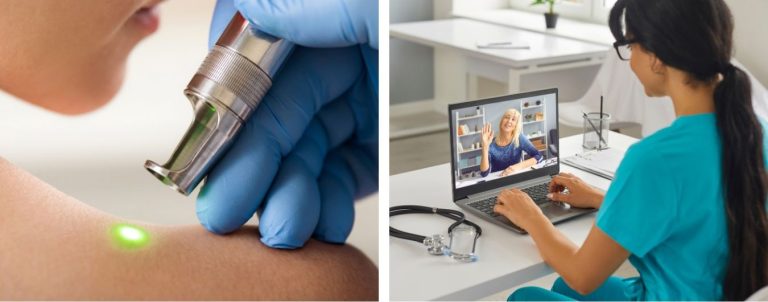Sustainability
A Healthier Planet, Healthier Skin
At the European Academy of Dermatology and Venereology (EADV), we believe that advancing skin health also means protecting the environment. Our commitment to sustainability runs across research, education, clinical practice, and every EADV activity, including our congresses and events.
Through the Climate Task Force we work to reduce the environmental impact of dermatology, raise awareness about climate-related health challenges, and inspire our community to take meaningful action.


Our mission at a glance
Promote
Raise awareness of how climate change affects skin health and dermatology
Contribute
to research and evidence-based solutions for a sustainable future.
Celebrate
initiatives and successes that advance green practices in dermatology
Collaborate
with healthcare providers, partners, and industry to drive change together
The EADV Climate Working Group will soon become the EADV Climate Task Force
Delivering Dermatology care and education in an era of Climate change
Progressive climate change is relevant to clinical and educational activities in Dermatology. This guidance is compiled through consultation with Dermatologists involved in Climate-sensitive medicine. It is written in the context of the EADV having a dual role of delivering education for its members and the public, but also as a gathering place for Dermatologists across the world to exchange ideas, share best practice and improve the care of their patients.
Healthcare is a core activity in society and is relevant to climate change both as a cause of environmental waste and greenhouse gas emissions and also in its role in managing the consequences of climate change on health. Each medical specialty and activity encounters challenges of delivering care in a sustainable manner and addressing diseases that change patterns in connection with climate change and migration.
This section outlines 9 areas for Dermatologists to consider across the range of their professional activities: how they run their services, the facilities they work in and how they obtain and contribute to education.
Key themes:
Progressing understanding, awareness and effective adaptation to Climate change
Uncertainty and lack of control are factors in the encounter with climate change. Providing patients, colleagues and institutions with relevant information and measures of progress is central to collective progress in addressing challenges.
Minimising waste and contributions to greenhouse gas emissions
Healthcare uses facilities and materials in delivering care, where both have implications for use of energy and production of waste. In turn, clinicians and patients undertake travel to deliver and obtain healthcare and education where both have implications for greenhouse gas emissions.
Improving the efficacy and efficiency of care
Delivering effective healthcare and education is the core activity of medical professionals. Maximising this in the setting of climate and financial constraints requires progress in the efficiency of delivery and the effectiveness of care.
Adopting good practice with careful use of resources, adapting to minimal travel and ensuring effective treatment choices maximises the personal and societal benefit of healthcare.
Turning Commitment into Action
Sustainable Clinical Practice
Dermatology can make a difference. We encourage and share:
- Low-carbon and waste-conscious approaches in clinics and hospitals
- Smarter prescribing and reduced reliance on single-use plastics
- Education on eco-friendly alternatives in dermatology




Greener Congresses & Events
Since 2020, EADV congresses have become models of sustainability, including:
- Congress content and focus on climate. Integrating climate change topics into the Congress agenda.
- Eco-conscious catering service. Planned to reduce food waste and priority to locally sourced food.
- Initiatives that reduce travel emissions and promote sustainable mobility.
Research & Education
We bring sustainability into scientific discussion and learning by:
- Supporting studies on climate change and its impact on skin diseases
- Offering podcasts, webinars, and sessions dedicated to environmental topics
- Contributing to global health and climate debates from a dermatology perspective




Partnerships & Collaboration
Pharma and medical device companies are significant contributors to the landscape of climate change and how to address it. Developing collaborations and mutual learning between the EADV, Dermatovenereologists and Pharma is a theme in the work programme of the Climate Task Force.
We believe that collaboration accelerates progress. With our partners, we:
- Explore sustainable alternatives to packaging and promotional materials
- Encourage responsible practices at industry-supported events
- Share best practices across the healthcare community
Advancing Sustainable Dermatology
High-quality patient care is at the heart of dermatology. By understanding how climate change and pollution affect skin health, patients can better manage their conditions, risk factors, and ageing.
Take Action and Join us by:
Talk to patients about how climate change affects skin health.
Join awareness campaigns and share information on your website, social media, or clinic.
Work with your professional body to shape sustainability policies.
Connect with colleagues in other specialties to align strategies.
Engage healthcare leaders to advocate for sustainable policies.
Support education for students, nurses, and trainees on climate and health.
Collaborate nationally and internationally to drive collective change.
Recommendations for a greener dermatology practise
Patient care and their experience is of key importance for all Dermatologists. Patients will benefit from a clear understanding of how they can manage their skin disease, risk factors and ageing better if they understand the effects of changing climate patterns as well as pollution. We can inform our patients and the public and support sustainable practices on multiple levels: personal, institutional, national and international. Knowing what to do and helping others know what to do is necessary for effective action. Doctors are respected in society and may serve as role-models.
WHAT YOU CAN DO
- Talk to patients about climate change and its effects on health.
- Be part of awareness campaigns and include information on environmental aspects on website, social media and office premises.
- Contact your national professional body and get involved to establish their policies and future plans with respect to sustainability
- Contact medical colleagues in other specialties to determine relevant policies and plans in their services.
- Contact your political and administrative health care leaders in the province/state/country to establish central policies and plans with respect to sustainable healthcare.
- Create and support educational modules for medical students, nurses and other healthcare trainees with reference to sustainability and climate change awareness in patient care.
- Collaborate with national and international colleagues to gather and coordinate change.
It is sometimes difficult to know whether you are doing what you think you are, or making progress. Audit is a simple way of helping address that. Clinical audit is well established in patient care. Auditing our measures with respect to sustainability is similar and easy to undertake on a personal or institutional basis. It increases our awareness as we do it and creates a baseline from which we can measure progress.
Regional or national audits with agreed standards can help establish change and clarify priorities in healthcare.
WHAT YOU CAN DO
- Undertake annual audits in the different areas of carbon reduction management.
- Implement waste audits to track compliance. Identify areas that need improvement.
- Manage inventory to minimise unused supplies and waste
- Include metrics of improvement, e.g. change from previous year / audit cycle in percent.
- Set targets for future reductions and standards against which to be audited.
- Share audit activities across institutions to spread good practice and visibility.
Research on sustainability and climate change is under-represented in high-impact dermatology journals. This limits the ability to influence guidelines and policy, while also hindering clinicians from making well-informed decisions, as sustainability remains an overlooked factor in clinical decision-making.
WHAT YOU CAN DO
- Encourage colleagues and registrars to engage in sustainability research.
- Encourage high-impact journals to incorporate carbon footprint analysis as a secondary endpoint so that environmental accountability is included in all interventions and clinical trials.
Medical practice produces a large amount of waste – both in the creation of medical products and in the outputs of medical care.
WHAT YOU CAN DO
- Provide recycling bins in every clinical environment to enable segregation of waste streams
- Properly separate and dispose of waste, including pharmaceutical waste, according to local regulations.
- Recycle non-contaminated surgical waste
- Use only recycled paper, where paper needed.
- Minimize the use of disposable products and replace them with reusable or recyclable alternatives where hygiene permits.
- Buy office and medical supplies from certified sustainable providers.
- Choose environmentally conscious suppliers and work with vendors to provide recyclable or biodegradable packaging
- Partner with a certified medical waste recycler. To safely process and repurpose materials.
- Donate unused medical supplies to other health initiatives.
- Provide educational material and periodic training on waste management and reduction. Include it as a mandatory training element.
Our workplace consumes energy, which is both expensive and potentially wasteful. Minimising energy waste in our medical and conference settings will reduce cost and conserve carbon.
WHAT YOU CAN DO
- Adjust heating/air conditioning levels and periods.
- Purchase renewable energy
- Initiate a workplace energy evaluation survey:
- Install solar panels
- effective insulation
- double glazing
- LED lighting
- Install water-efficient faucets and toilets
- Establish “turn off” policy/systems for equipment and motion-sensitive lighting
Skin surgery and procedural Dermatology is a large component of patient care. It typically generates waste in terms of the personal protective clothing and drapes and with respect to the instruments, their sterilisation and packaging. Published audits have demonstrated the range of practices and the importance of dedicated re-usable instruments and established recycling facilities.
WHAT YOU CAN DO
- Review glove use policy: sterile, clean nitrile, clean hands
- Avoid single use instruments
- Minimise number of instruments per pack
- Minimise surgical gowns and drapes where hygiene permits
- Ensure clear refuse collection for re-cyclable theatre waste
- Recycle non-contaminated surgical waste
- Audit your waste in the surgery setting
Read more: https://doi.org/10.1093/bjd/ljae090.068
Travel to and from clinics and conference settings is a large part of the carbon footprint of any medical activity. For Healthcare settings this includes patient and staff travel. For conferences it might be international air travel: 80% of the carbon footprint of an international conference is attributed to the travel of participants.
The 3 key questions for any journey are:
- Can it be avoided through changing the nature of the service provided to a virtual platform?
- For patient care, is it possible to package care such that more is delivered in a single visit, hence avoiding more travel?
- If travel is needed, how can it be undertaken in the most sustainable manner?
WHAT YOU CAN DO
- Consider the hierarchy of transport saving: walk > bike > e-bike > car-pooling > public transport > Electric car > internal combustion engine car
CLINICAL PATHWAYS
- Offer telephone or video consultations
- Integrate store-and-forward teledermatology solutions for patient triage
- Offer “book direct to surgery” service from teledermatology or virtual consultations for patients needing diagnostic or small excision surgery
- Offer “see and treat” service for potential skin cancer.
- Adopt policies to promote remote access to multidisciplinary meetings
- Provide outreach clinics: healthcare staff travel to community setting.
EDUCATIONAL
- Adopt policies to promote access to remote educational activities.
- Minimise educational “fly miles” by looking for alternative transport or model of educational activity.
- Adopt public transport/cycle/walking options and incentives within conference cities.
- Educate others/trainees to adopt climate sensitive Care and Education pathways
STAFF TRAVEL AND WELLBEING
Develop/adopt/promote staff transport policy alternatives supporting to driving to work.
Examples:
- collaborate with local public transport providers for season ticket discounts
- provide tax incentives for purchase of cycle transport options (see bike to work scheme)
- provide change and shower facilities in the workplace
- provide safe cycle storage facilities in the workplace
Most medical record systems in Europe are partly or completely digital. This enhances communication and precision of record keeping. It avoids the use of paper which has implications for paper manufacture, storage and waste. There are additional considerations in terms of access to a patient record and its completeness.
Communication with the patient and other healthcare professionals is sometimes an interface between digital and paper, introducing waste and potential data loss.
Digital systems also have their potential for waste and care in their use enhances their value as a sustainable work practice.
WHAT YOU CAN DO
- Digitize patient records, appointment scheduling, and internal communications.
- Avoid using paper
- Reduce your online carbon footprint: Read more – relevant to individuals, organisations and dermatological societies, minimise high definition graphics on webpage
- Reduce carbon footprint of electronic mails – Read more
- Do not cc. people unnecessarily, instead of uploading attachment use online share folder/file, delete email trail unless necessary.
- Do not print email
- Do not unreasonably use artificial intelligence tools
Pharmaceutical products and their manufacture carry significance for the sustainability of medical care. How they are produced, the miles incorporated in their creation and distribution and how effective they are, all play a part in a calculation of their sustainability credentials. Large pharmaceutical companies contribute to that credential by the policies that run the company.
Careful review of these characteristics will help you make better choices with respect to the care you are providing. Discussion with local, regional or national representatives will foster a partnership in delivering sustainable, high quality patient care.
WHAT YOU CAN DO
- Remember that the financial cost of care is a factor in ensuring the sustainability of a model of care and use of a prescribed agent. IE extreme cost will limit the broader sustainability of any treatment in a system where finance is limited.
- Avoid overprescription and polypharmacy; prescribe only necessary amounts.
- Collaborate closely with pharmacists to ensure environmentally friendly medication use and disposal.
- Maximise recycled input and recyclable output in pharmaceutical product chain.
- Ask Pharmaceutical/Cosmeceutical suppliers to provide the carbon footprint of their products.
- Ask Pharmaceutical/Cosmeceutical supplier to provide the sustainability plan and credentials of their company as a business.
Dermatology and Venereology treat conditions that affect people differently based on their skin type, ethnicity, socioeconomic status, and geographic location. Climate change and migration can result in all these differences coming together in your clinic. Addressing these disparities requires a conscious effort to integrate equity and inclusion into dermatological education, research, and practice.
WHAT YOU CAN DO
- Minimise the effects of Climate-related disease change and migration by implementing the policies and services outlined in this document.
- Educate yourself and your team on how dermatological conditions present across diverse skin tones, and advocate for inclusive medical imagery in teaching materials.
- Work with community organizations to increase outreach and screening in underserved areas.
- Offer teledermatology services where possible to improve access for rural or low-mobility patients.
- Support and mentor underrepresented groups in dermatology to diversify the field.
- Incorporate social determinants of health into patient assessments and care plans.
- Advocate for public policies that expand access to dermatological care regardless of income or location.
Stay connected
Follow our journey towards a more sustainable dermatology community:
Subscribe to the EADV Newsletter
Read sustainability features in EADV News
Join us on social media for updates and inspiration

